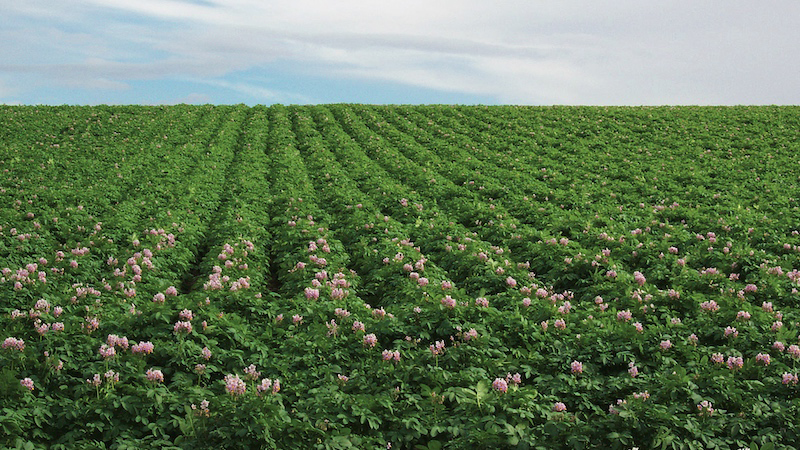What It’s Really Like to Grow Hops

Growing hops is not as easy as it looks. Patrick Smith, VP of B.T. Loftus Ranches in Yakima, WA, says it’s critical to have a market for your hops before you even begin to think about planting.
Production of hops in the U.S. continues to climb, with a record high of 107 million pounds harvested last season, according to figures from the USDA. While this growth is still nothing compared to the tree fruit industry overall in the U.S., interest in hops as an alternative crop — especially among fruit growers — continues to brew.
Dan Wiesen, Co-owner of Empire Hops Farm in Empire, MI, grows cherries and apples and used to grow apricots, peaches, and asparagus. About 10 years ago, Michigan State University put on a presentation on hops cultivation as interest was growing. This in turn piqued Wiesen’s interest.
“The reason we looked into growing hops was for some diversification. We didn’t grow those other fruits anymore except for apples,” he says. “We had some ground that was pretty low and it’s not a good apple site.”
For Patrick Smith, Vice President of B.T. Loftus Ranches in Yakima, WA, his family made the opposite move, having farmed hops for more than 50 years before moving into tree fruit.
“After a period of years in the 1980s where conditions were quite good in hops, we decided to take some of the profits from those years and diversify our business and do apples,” he says.
But how different is hops growing from traditional tree fruit? Smith and Wiesen talk about the differences and similarities between the two types of crops.
Different Crops, Same Challenges
Both Wiesen and Smith say that hops fit well with tree fruit orchard tasks. Hops require strings to be hand-tied to the trellis in the early spring, followed by a manual training of the hop bines onto the string that supports the plants’ vertical growth for the duration of the growing season. These activities are very labor-intensive in March through May, a time when orchard labor needs may be lower.
“Sometimes of the year it works out quite well, particularly in mid-spring where the hop labor needs are very high and the needs in tree fruit are relatively lower,” Smith says. “As those spring labor needs in hops taper off, things in the orchards would begin to pick up with thinning.”
Harvest is a challenge for Smith because hop harvest tends to fall right in the thick of apple harvest. But Wiesen says optimistically that hop harvest keeps his labor busy in between cherry and grape and apple harvests. But, no surprise, labor is still a key need with hops, and that’s just exacerbated with an operation that has other crops picking at the same time.
Key Differences
“One of the biggest differences between the two is kind of the scale of the two and how hop growing and hop farms tend to be very concentrated,” Smith says. “To be an economically viable unit in PNW requires somewhere in the order of a minimum of 450 acres of hop production.”

Patrick Smith
Another key difference between hops and tree fruit production is the need to be located close to a processing facility. Smith says in the Pacific Northwest most operations harvest, dry, and process their own hops.
“Once we cut the bine in the field, it needs to be processed and begin drying in a few hours at the absolute maximum. We would prefer to see that within one hour. The farther those fields are from the processing facility, the more expensive it becomes to harvest that field,” he says. “A lot of apple growers may be 100 miles or more away from their CA (Controlled Atmosphere) and packing facilities. A typical hop farm would be about 600 acres of hops, and those fields would largely be within 10 to 12 miles of the harvest facility.”
The risks for both hops and tree fruit are inherently different, Smith says.
“A poorly timed hailstorm will completely wipe out an apple orchard’s economics for the year,” he says. “In hops, we don’t seem to have that same degree of risk from summer weather issues.”
The production demands are also different.
“Yields on hops, at least in our area, tend to be less variable than yields on apples. Every individual cone is not weighed and graded like it is in apples,” he says. “When we’re looking at our apple production, we’re trying to get the greatest percentage of fruit in that right size/right color/right grade for the fresh market.”
Smith notes that, fittingly, the hop industry is “prone to hangovers.” Once processed, the cones can be stored for a long time.
“If we have a big crop one year, a record crop, that inventory can persist in the global system, in the global supply chain, for many years,” he says. “The industry is prone to long cycles. We’ve been in a very good cycle for most hop growers for 6 to 10 years of pretty good market conditions. That’s unprecedented that it’s been that long of an up-cycle.”
Prior to that, Smith says there were about 15 years of poor market conditions, and the number of hop growers in the Yakima Valley was cut in half.
“It wasn’t very many years ago where our apple production was subsidizing our hop production,” he says. “That’s a great example of why diversification is important. It’s important for all of us to remember that all industries move in cycles. We need to be mindful of where in the cycle we are.”
Still Want to Grow Hops?
So, even after all that, you’re still interested? First things first, your climate needs to be right if you’re looking to add hops. Smith points out that the hops growing season is quite long, so locations with snow on the ground into April would not be suitable.
“Hops are plants that are influenced by the length of daylight, so it’s kind of like a mum,” Wiesen says. “When the days get shorter they change from a vegetative state to a reproductive state. You have to have 15 to 15½ hours of sunlight in order to grow them properly.”
Smith says a sufficient period of dormancy is necessary, too.
“If you’re in a region where you don’t get a good hard frost for a number of weeks in the winter, your area is not ideal for hop production,” he says.
Even if you have a suitable climate, before you plant, it’s critical to have a market for your hops.
“I would really start with developing a market before you make the investment,” Smith says. “It’s just like fruit growing or any other new business. It’s a lot of work, and if you’re not sure you can sell what you produce, it’s tough to recommend somebody put in that amount of work with no guarantee or expectation that they’re going to be able to sell it.”
It’s no easy task to get set up in hops, but experience with other high-density fruit crops may give you a leg up.
“The cost to get established is pretty high. It’s about $15,000 per acre to get started, that’s just to get it planted, that’s not for any care afterward,” Wiesen says. “For people who do grapes or high-density apples, that transition to hops will be easier for them because they are used to putting in a lot of money up front and more detail care. There’s a lot of labor that’s involved also, and there’s labor available on those farms that grow fruit.”
Understanding that up-front cost, it’s not only essential to have a market for your hops. You have to produce a large crop, or at least a consistent amount to make it worth the brewery’s while to contract with you.
“I can’t take a bucket of bolts to GM and say ‘Can you buy these from me? They’re really good bolts,’” he says. “The scale that it has to be done on makes it very difficult for breweries to deal with small crops. You can’t make money on an acre of corn, an acre of soybeans, or an acre of almost anything that pays.”
Wiesen also says it’s important to understand what varieties will work in your region, too. Some varieties popular with breweries may not be successful in your climate.
“Talk to your breweries you are selling to and find out the varieties that they are looking for and they use and need. Find out what they want and what you can grow in your area as well,” he says.
It’s also important to consider that hops are a food product and there are specific food safety standards and guidelines to follow.
“It hasn’t been hard to adapt to that because we’ve been doing it for years with fresh market apples. We have a number of inspections, we do it every year. We have a GAP certification and a LEAP certification,” he says. “I can tell people now we can guarantee that people are going to be more successful than we were. They don’t have to learn this stuff because we’ve made those mistakes.”










